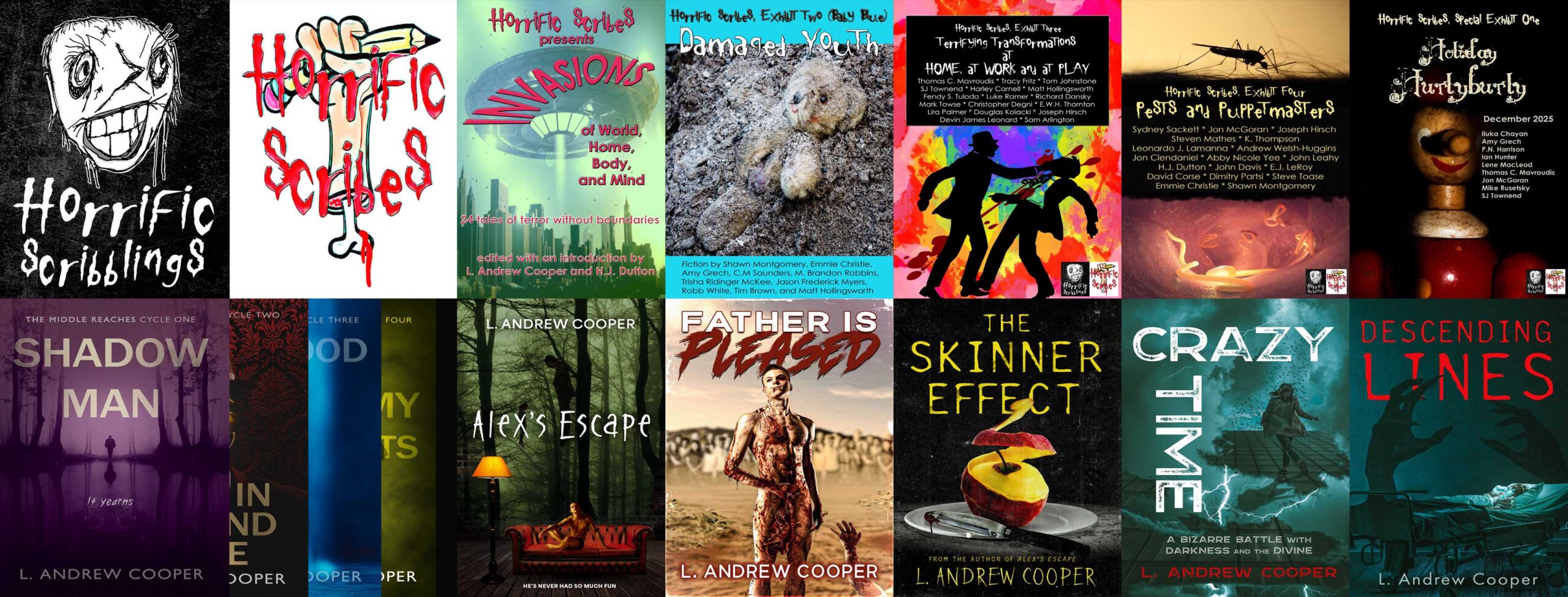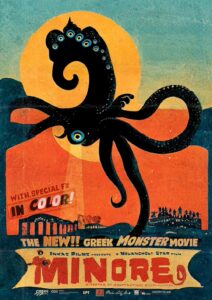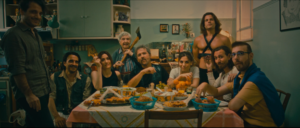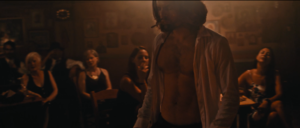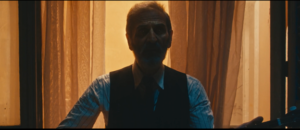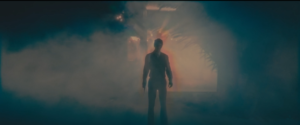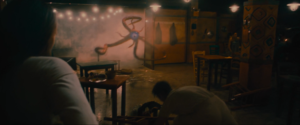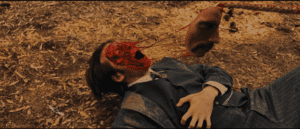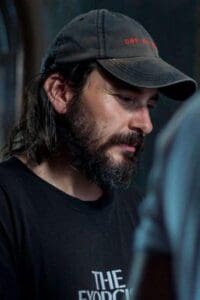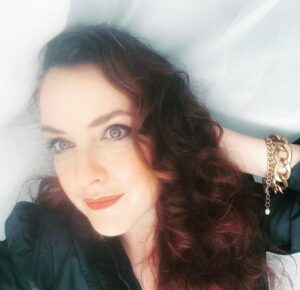Interview with Filmmaker Konstantinos Koutsoliotas, with Co-Creator Elizabeth E. Schuch: Minore (2024)
Minore is the delightfully offbeat horror-fantasy-comedy from Greece that won Best Horror Feature and Best Monster/Creature Visual Effects at the Miami International Science Fiction Film Festival earlier this year. In this interview, made possible by the film’s co-creator Elizabeth E. Schuch, director Konstantinos Koutsoliotas discusses the film’s inspiration and bizarre but effective combination of elements.
Minore
When mysterious creatures invade a Greek seaside port, a misfit band of musicians, tourists, bodybuilders, and grannies unite to save the city in this quirky action-comedy.
The Interview
1. The Lovecraftian. Even if your creepy-eyed old musician character, Mr. Nikodimos, didn’t ramble about the “Old Ones,” the design of your creatures would put Minore in the “Lovecraftian” category. Have you read much Lovecraft and/or other “cosmic horror” writers dealing with the Cthulhu mythos or similar types of dark fantasy world-building? If so, what are some of your favorites, and why? If not, why did you make a film that would fall into this category? What do you think keeps drawing viewers to Lovecraftian films? Is Lovecraftian fiction popular in Greece? Most Lovecraftian films have pretty bad creature effects, but yours are impressive. How did you pull that off?
KK: In my angsty teenage years, I discovered Lovecraft via E.A. Poe, and both writers still remain two of my favourites! I fell in love with Lovecraft while reading “Celephaïs” (which was my first animation film back in art school) and “The Tomb.” The idea of the outsider really appealed to me back then, and afterward I tried to read everything of his I could get my hands on. The fear of the unknown / the indescribable cosmic horror I think speaks to the very core of some of us! The flowery way he writes combined with the way he lets the imagination do all the work made a killer combination! Loved the stories so much to the point that all three of the films I directed I hope have some aspects of that DNA in them! And it’s more of a feeling I think–a feeling that exists maybe to various degrees in some of the other writers of cosmic horror. My absolute favourites of those others are “The House on the Borderland” by William Hope Hodgson, the uneasy feeling you get while reading “The Yellow Sign” by Chambers, and the unique melodic way Lord Dunsany writes! For those not exposed to those worlds and are keen to get infected with the virus, I would really recommend the podcast HP Podcraft https://www.hppodcraft.com/ by Chad Fifer and Chris Lackey. They have really deep dived into those worlds, and it’s a great intro to the genre!
Regarding the creature effects, we are blessed to have been working making VFX and monsters for the last 20 years but cursed to have had actually ZERO budget for the post in Minore. In Greece, unfortunately, this kind of film making is frowned upon by the establishment and the major critics, which means working with extremely limited budgets. So, we storyboarded everything and went in the shoot super prepared! It was literally editing it in camera because it was a very short shoot and adopting a B movie look that we could keep consistent throughout the film rather than going for something much higher quality that we would not be able to keep up. Then it was working 15 hour days for me and Elizabeth to pull it off in time for the deadline! The monsters are inspired by the Mediterranean “evil” eye with the addition of some tentacles, and the big mother is a version of HP’s Azathoth wrapped in Greek pita with extra tzatziki!
2. The Ever-Present End. An early shot in Minore shows a man wearing a sign that says, “Armageddon is coming,” and a creature invasion of the magnitude occurring could indeed herald the apocalypse. Do you consider Minore an apocalyptic film? Why or why not? Catastrophic, apocalyptic thinking, especially in the horror genre, surged around the turn of the century and then never went away, as the blockbuster A Quiet Place: Day One, another creature invasion film, demonstrates. Minore might seem close to that sort of film, but the poster, which I love, makes it look like a retro, 1950s sort of creature feature. Do you think it’s closer to the current or to the classic mold? Why?
KK: We tried to conform a bit to the classic 50’s monster mould. Part of it is our love for that era of movie making, and the other part is a fascination with the Fear of the Unknown, as I mentioned before. When Elizabeth and I were writing the film, the monsters were a metaphor for the economic crisis that Greece was in back then. Rows and rows of closed shops, businesses that went under, empty high streets, it seemed like it was the end times, in a way. By the time we found the minimum funding we needed to do the shoot, the economy was on the rise again, but then Covid was the new reality. Still, the fear of the unknown remained. That is what gave birth to Minore, really. When you have no control over your reality and the end looms near, what do you do?
3. Build Up, Part One. Even though ominous hints about what’s coming start immediately, the film devotes significant early time to building a large cast of characters involved in stories unrelated to invading creatures. Most creature features don’t emphasize character: why did you make character development a priority? What effect do you expect developing these plots for characters who all run into the main creature plot has on your viewers? Do you expect character injuries and deaths to be more shocking? Funnier? Either one, depending on who it is?
KK: In life we tend to care much more about what happens to people we know well, rather than a stranger’s plight you see in passing watching the news. Personally, I get turned off watching action sequence after action sequence if I don’t care about anybody in it. I feel it’s human nature. And there’s something magical getting to know the weirdest, unique side of each protagonist, while at the same time still trying to retain their individual humanity on screen. When you see how one of these characters interacts with the mundane, then introduce a tentacle into the mixture, it definitely makes it more fun! Love the films and stories that do that as well!! I mean, read pretty much anything from Stephen King and you are there. Films like Attack the Block, Grabbers, The Mist, The Fog, The Host–even Godzilla comes to mind– they are similar in genre and approach to what we trying to do! Also, we wanted to mirror a little the pace of life in the mediterranean–where even in an emergency things proceed at their own special speed.
4. Guys on Film. While many creature features please viewers with images of partially undressed women—even Alien (1979), hailed as feminist by some, shows Ripley running around in her underwear—Minore balances the score a bit with shirtless men, particularly a dancer and a sailor, who both get reactions from women that confirm their sex appeal, as well as a bodybuilder in love with his pecs, who may overestimate his attractions. Does the emphasis on male rather than female flesh make a statement? How does this sort of sex appeal add to the overall experience of the film? Have audiences reacted to it? If so, how?
KK: It was obviously intentional. Greece is still pretty strong on Patriarchy and the teachings of the Orthodox church, so we tried to go a bit against the grain. We love to flip cinema tropes–and instead of a shirtless or near-naked female at every turn, we’ve provided man-flesh in the same way and had a blast doing it! For the most part, the audience seemed to have enjoyed and appreciated the gesture, and there was also a little bit of begrudging discomfort. Either you’ll enjoy it, laugh at the silly excess of it, or if someone’s uncomfortable with it… then it’s fun to ask why.
5. Build Up, Part Two. As I mentioned, hints of what’s to come begin with the film, and hints escalate to mysterious fog, strange dreams, and melty corpses, but although there’s something hard to identify in the water early on, the promised creatures don’t show up clearly until halfway through the film. How do you think this slow build toward the creature reveal—you might call it a “slow burn”—affects audiences?
KK: I think this is the most Lovecraftian element of this film. We had a limited shooting time and budget and needed to be as efficient with effects and monster visuals as possible. Using the Jaws method of showing less, to hopefully build up anticipation. The anticipation for me is better than the release and it gives the audience time to get to know the heroes of the story. Minore is really close to the film we had in our head in the first place! I’m not sure if you’ve ever tried to get anything done in Greece in a hurry, but there’s a certain lack of urgency and absurdity that we wanted to capture as well–would it really just come down to your granny sorting it out? Probably!
6. Randomness or Fate? Car accidents occur in two very different scenes. At first, they seem like random violence, but given their contexts—who gets hit, when, and what happens afterward—they might seem a little more like fate. Do you think Minore puts more stock in randomness or fate? Is William, the sailor who visits Athens while searching for his father, following a cosmic destiny? Is everyone?
KK: This is one of the questions I try to answer myself! Is there some order in the chaos? Who knows! Maybe! There’s something very fateful about being in the right place at the right time… or the wrong one! Tried to pass the Lovecraftian idea that you are inconsequential considering the size of the cosmos but then… when all things go to hell maybe the answer like in Zorba the Greek is to Dance! No fear, no hope–freedom as Nikos Kazantzakis says! Maybe there is some order in that! Maybe our dancing waiter Alexis has got all the answers in the universe!
7. Music. William, Mr. Nikodimos, and others play instruments, particularly the bouzouki, another character is a dancer, and another is a painter. Why is art so important to the film? Music ends up playing a critical role in the story, and it might have something to do with the “music of the spheres,” which Mr. Nikodimos mentions in one of his ramblings. What is “the music of the spheres,” and why is music—especially the bouzouki—so central to your story?
KK: I think it’s one of the ways to have true freedom in a way. To get lost in it. A safe place from the bad stuff Outside. A way to put order in the chaos, create a world that you are comfortable with! Lovecraft aficionados will probably spot a bit of the violinist from “The Music or Erich Zann” in the story, a lone man trying to keep order in the chaos by keeping the gate shut with his violin. But for me I grew up with this strange mixture of art and music. As a teen I used to read Lovecraft in the bus on the way to my art class, and once there, while drawing I heard a band of bouzouki players practising every day in the same space with us. Cosmic horror, art and music used to be a part of my everyday life growing up, so definitely it’s a bit personal as well! Also, someone had to be the first to combine Bouzouki with Lovecraft!
8. Build Up, Part Three. Just before the creatures reveal themselves to major characters (and the film’s audience), a shot from a creature’s perspective leads up to its attack, and a moment later, a reverse shot outside its perspective reveals it’s a floating eye with tentacles. Why did you decide to use the camera’s eye as the eye’s… eye? After this attack, the film changes. There’s faster action, lots more gore and slimy goo, and a lot more (sick) humor, such as using a fresh corpse’s intestine as a rope to climb to safety. After all the buildup, what do you think the sudden flurry of action and emotion does to your audience? Do you feel like the tone of the film shifts, or does it continue from what comes before?
KK: That shot was a tip of the hat to Coppola’s shot in Dracula when the vampire approaches the mansion and of course the Evil Dead creature giving chase in the woods! Loved those films–and of course the things you love affect the way you shoot. There is definitely a shift in the film. I think the first big hint for me comes with Nikodimos’s accident; the over-the-top result and the fact that he goes out for a walk after that should be a hint that the film is now in B movie territory. But for sure we took a page out of Rodriguez’s From Dusk till Dawn playbook. We just wanted to have fun with it!
9. I Laughed at That. Although Lovecraftian writing is generally serious, Lovecraftian film often can’t resist humor. What made you decide to throw comedy into your action-horror-fantasy blend? Although quirky characters have funny bits throughout the film, the comedy comes faster after the creatures attack. Much of the humor goes hand in hand with gore, such as a head getting zapped to oblivion or a face getting ripped off with complete cleanness. Assuming I’m right… why is the gore funny? Why, when a guy’s face gets ripped off, am I snickering instead of scared? Why, assuming I’m right, do you want me to be snickering?
KK: We do! The world has been put through its paces with Covid and everything in the last couple of years; we just wanted to make something fun–that people hopefully leave the cinema having had a good time for an hour or two. And fun is definitely a form of release from the build up! Love fun gore, the OTT stuff–the likes of Peter Jackson’s Dead Alive (zombies meet lawnmower), Evil Dead, Army of Darkness, From Dusk till Dawn. Goes definitely more into the comedy rather than trying to be realistic. Like the gangster that is chasing after his skin, and being a bit upset because he lost… face.
In real life I would probably faint (like the typical Lovecraft character) if someone lost his face in front of me.
Life is absurd, and even in the worst times it can still be a comedy. We really wanted to embrace the chaotic joy of it all and take people on a silly but very Greek ride.
10. Access! How can readers learn more about you and your works (please provide any links you want to share)?
Our Company: Melancholy Star https://www.melancholystar.com/
Konstantinos Koutsoliotas’s website: https://www.konstantinoskoutsoliotas.com
Konstantinos Koutsoliotas on Instagram: https://www.instagram.com/melancholy_k
Elizabeth E. Schuch’s website: https://bio.site/elizabethschuch
Elizabeth E. Schuch on Instagram: https://www.instagram.com/elizabetheschuch
About the Filmmakers
Konstantinos Koutsoliotas
Konstantinos Koutsoliotas is an award-winning VFX artist with over 15 years of experience in the industry. Currently he is working as a visual effects compositing supervisor at Herne Hill media in Toronto while at the same time moonlighting as a filmmaker with three award winning features under his belt and a two-part documentary that he co-directed with his partner Elizabeth E. Schuch.
Elizabeth E Schuch
Elizabeth E. Schuch is an award-winning filmmaker with a career spanning directing, storyboarding, design, VFX and indie feature production. Her award-winning directorial debut, The Book of Birdie, showcases her passion for female-driven genre filmmaking. Elizabeth co-directed the epic documentary God’s Soldiers: Siege of Malta and co-created the cult Greek monster movie Minore.
Beginning as a set designer, she won Chicago’s top award for theatre, participated in the Berlinale Talent Campus, and trained in VFX in the UK. Specialising in storyboards for VFX, Elizabeth works in a range of media: commercials, factual, TV, titles, graphics, IMAX, VR, live events, and features (including Wonder Woman.) Elizabeth is the lead producer at Melancholy Star studio in London, Greece and Toronto, and the art director for the celebrated Fantaspoa IFF in Brazil.
